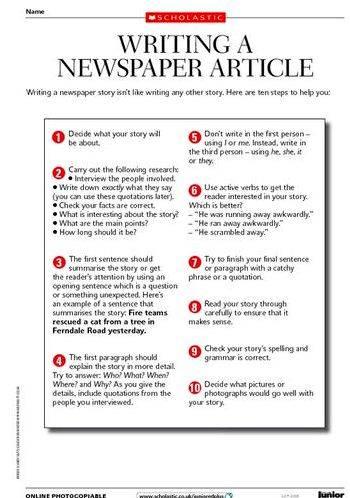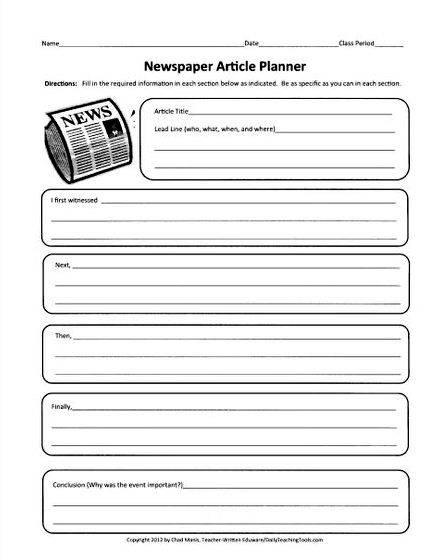

The learner will:
- identify the core democratic principle Freedom of the Press and the responsibilities that go with it.
- identify basic elements in newspaper article content.
- write a newspaper article about something that they or others are doing that is an example of giving time, talent, or treasure for the common good.
- identify and use writing mechanics of an effective newspaper article.
- participate in peer editing.
- copies of newspapers (including online editions)including school, local, regional, state, national, and international
- group and student copies of Attachment One: Writing a Newspaper Article Organizer/Rubric
- student copies of Attachment Two: Newspaper Article Editing Rubric
- writing materials or computer access
Instructions
Day One: Anticipatory Set: Ask the learners to form groups of three or four students. Give each group a copy of a different newspaper, preferably one national, one state, and one regional or school newspaper. Tell the group to get familiar with the paper, looking at headlines that grab their attention and grouping and counting the types of articles included in their paper(try to group them in meaningful ways, such as three foreign stories, eight local news, two weather related, etc.).Ask each group to prepare a quick report telling about their paper, including the number of sections and the types and numbers of articles included.
Have each group take less than two minutes to describe the contents of their paper. By listening to others, students gain a sense of the differences between the papers. Discuss the major differences for a few minutes.

Ask the learners to recall the first amendment rights as it pertains to news. Freedom of the Press is fundamental to our United States tradition of democracy, but along with that “right” comes the need for responsible news reporting. (First Amendment: Congress shall make no law respecting an establishment of religion, or prohibiting the free exercise thereof; or abridging the freedom of speech, or of the press; or the right of the people peaceably to assemble, and to petition the Government for a redress of grievances .)

Tell the learners that people read newspapers differently than they read other forms of written material. People who read newspapers usually scan headlines, images, subtitles, and authors. Then they read the articles of interest to them first. Because of this, a newspaper article has a unique organizational structure. It must get the readers’ attention quickly with a headline and give concise basic information in the first paragraph. The article includes the most important information first and the least important information last. The article should include the five W questions: Who. What. Where. When. and Why? A quote or two lends authenticity to the article.
Share with the learners the following helpful hints for preparing and writing a quality article:
- Audience: Keep in mind who will be reading your story.
- Accuracy: Be sure the facts are correct.
- Research: Complete any background research on the story topic and check the facts to be sure they are accurate.
- Interviews: Schedule interviews, prepare questions ahead of time, and take notes during the interview.
- Writing: Be sure that all of the components of writing a good story are included.
- Images/pictures: Choose images that will draw attention and help convey the story.

Give each group a copy of Attachment One: Writing a Newspaper ArticleOrganizer/Rubric. Tell the students to work together as a group to choose an article to read from the newspaper (probably from the front page). Have them locate the information from the article and record the evidence on the worksheet.
Allow ten to fifteen minutes for this activity. Have each group share their information with another group.
Brainstorm with the class examples of giving time, talent, or treasure for the common good that they have been part of or that they know about in the community. Determine which might be good topics for a news story. The students may all write about the same topic, or students may write articles about different events.
Give each learner a copy of Attachment One: Writing a Newspaper Article Organizer/Rubric. They use this as an prewriting organizer for writing an article about an event involving civic engagement. If students find that they are unable to complete all the sections in the organizer/rubric, they need to research the details and complete it. Tell the learners to refer to the organizer as they write a first draft of their news article.
When the first drafts of the news stories are complete (probably afew days later), the learners share their news story with a peer, using Attachment Two: Newspaper Article Editing Rubric as a tool to evaluate each other’s writing. Give students time to revise and edit their work according to the suggestions of the peer editor and their own self assessment. (The teacher may also use the Newspaper Article Editing Rubric to evaluate the articles and give feedback and grades.)
Have students submit their stories for publication in an appropriate newspaper.
Standard PCS 07. Skills of Civic Engagement
Benchmark HS.1 Utilize the persuasive power of written or oral communication as an instrument of change in the community, nation or the world.
Benchmark HS.2 Discuss a public policy issue affecting the common good and demonstrate respect and courtesy for differing opinions.
Benchmark HS.3 Participate in acts of democratic citizenship in the community, state or nation, such as petitioning authority, advocating, voting, group problem solving, mock trials or classroom governance and elections.
Benchmark HS.4 Analyze and synthesize information to differentiate fact from opinion based on the investigation of issues related to public policy. Discuss these issues evaluating the effects of individual actions on other people, the rule of law and ethical behavior.
Previous answers to this question
This is a preview of an assignment submitted on our website by a student. If you need help with this question or any assignment help, click on the order button below and get started. We guarantee authentic, quality, 100% plagiarism free work or your money back.
 Get The Answer
Get The Answer